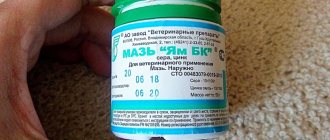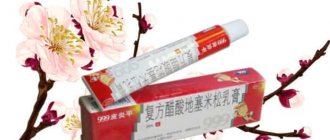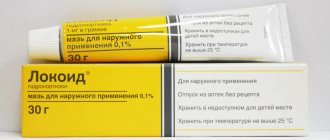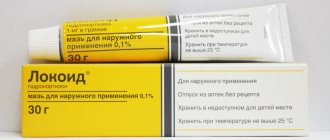Ointment "Yam BK" is a bactericidal-fungicidal drug intended for the treatment of skin diseases of warm-blooded animals (mainly dogs, cattle, poultry). The product is contraindicated for use in cats due to sensitivity to the components of the medication. It should be used for the following diagnoses: eczema and dermatitis, which can be caused by tick bites, as well as trichophytosis and hoof lesions.
Dosage form
YAM BK ointment is produced in Russia. In appearance it is a dense, brown-brown mass with a strong odor. The paste is packaged in plastic jars from 10 g to 1 kg or polymer tubes from 10 to 550 g.
The drug is stored in a dry place, protected from the sun, in the manufacturer’s bottle under a tightly closed cap at a temperature of 0 – 30℃. Shelf life 24 months from the date of issue. A jar weighing 50 g costs about 100 rubles.
Medicinal properties
Yam BC is prescribed for skin diseases as an antiseptic, exfoliating, astringent, wound-healing, drying, regenerating, bactericidal agent with a pronounced acaricidal and fungicidal effect.
- Sulfur upon contact with organic substances of the epidermis forms pentathionic acid and sulfides. These compounds improve blood supply to tissues, increase local immunity, exfoliate crusts, and trigger regeneration mechanisms. At the same time, they suppress the vital activity of pathogenic bacteria, fungi, and scabies mites.
- Zinc oxide dries, heals tissue, stops the inflammatory process, and absorbs toxic waste from pathogenic microbes and parasites. After application, it forms a thin film on the surface of the lesion, which protects against external irritants and microbes.
- Salicylic acid reduces inflammation, pain, itching, exfoliates scales and crusts, and destroys harmful microorganisms.
- Birch tar improves blood microcirculation, cell nutrition, blocks the spread of skin mites and fungi, resolves swelling and inflammation.
- Phenolic-free creolin disinfects and has pronounced acaricidal and antifungal properties.
- Gum turpentine increases blood circulation, alleviates discomfort, pain in the affected area, and disinfects.
Lanolin and petroleum jelly soften, form a protective film, retain moisture, and prevent skin dryness, which can be caused by medication components.
Owner reviews
Oksana, owner of a 3-year-old cat:
“When our pussy developed shabby spots on its head, characteristic of lichen, we immediately went to the hospital. The veterinarian prescribed an ointment for external treatment, talking about the safety of the product. They applied it for a week. Now there is no trace left of the lichen. The fur quickly recovered in the shabby areas. Cheap and good drug. Special thanks to our veterinarian."
Victoria, owner of a 4-month-old kitten:
“We used YAM BC to treat lichen in our kitten. After applying it, it all started to burn, so I had to wash it off immediately. It was not possible to verify how effective the product is. I would like to draw the attention of cat owners to the fact that the drug is quite dangerous.”
What does it help with?
Yam BC is prescribed for parasitic dermatitis, eczema:
- Ringworm – microsporia, trichophytosis. Fungal skin infection.
- Scabies – sarcoptic mange, notoedrosis, cheyletiosis, psoroptosis. The disease is caused by sarcoptoid and psoroptoid mites.
- Eczema is a non-parasitic inflammatory skin disease.
Before using the ointment, it is important to determine the cause of the skin problems, otherwise the treatment will not bring results. If an animal has been diagnosed with ringworm or scabies, then it is necessary to disinfect the room, care items, and protect the pet from re-infection. When eczema develops, the cause of the inflammation must be eliminated, otherwise it will return.
See our review of other ringworm ointments for dogs.
Types and pathogens of lichen
Ringworm is a collective name for dermatological diseases with common symptoms. Limited hairless lesions with redness, rashes, peeling, ulcers, and sometimes scales and crusts appear on the skin.
Depending on the cause and pathogen, 4 types of lichen are identified in dogs:
- Ringworm - caused by dermatophyte fungi Microsporum and Trichophyton. In veterinary medicine, the disease is called dermatophytosis or, based on the type of pathogen, trichophytosis, microsporia.
- Pityriasis (multi-colored) - provoked by opportunistic yeast-like fungi. They normally live on the skin of animals and people, and begin to bother them under unfavorable circumstances.
- Pink is a mysterious disease that begins suddenly and goes away just as unexpectedly. The exact reasons are still not known. According to the main theory, the disease is provoked by a virus that “wakes up” when the immune system weakens.
- Weeping is a non-infectious skin lesion or eczema. The cause is identified separately for each animal. The disease can be triggered by disruptions of the immune and endocrine systems, improper feeding, allergies, neurological disorders, and mechanical damage to the skin.
It is not always possible to determine the cause of lichen by external signs. Laboratory tests are needed to identify the pathogen.
In a separate review, see symptoms and photos of lichen in dogs.
Instructions for use
The method of treating animals is the same regardless of the cause of the skin lesion:
- Mix the paste thoroughly as it separates into its components.
- Apply a thin layer evenly over the entire affected area, rubbing lightly and covering up to 4 cm of healthy skin around the lesion. There is no need to trim the fur, soak it, remove scales or crusts.
- If the treatment area is accessible for licking, cover the treated area with a bandage or wear a protective collar.
- Repeat treatments 1 – 2 times a day every day. The procedures are stopped when the papule disappears and the epidermis is restored.
The standard course of treatment for lichen and scabies lasts 7–10 days.
A more specific period depends on the size of the lesion. During this time, the itching gradually goes away, the crusts separate, the epidermis is restored, and new hair begins to grow.
10 days after the final treatment, control microscopic analyzes are performed. If parasites are detected, the course is repeated.
The treatment time for eczema depends on the size of the papule, the intensity of inflammation and is prescribed by the attending physician.
How to use
It is advisable to start treatment prescribed by a doctor based on research as soon as possible. Ideally, when the first signs appear. The sooner therapy is started, the faster the cure will occur and the less the infection will spread through the skin.
Hair clipping, removal of crusts and treatment with antiseptic agents is not required before starting treatment.
Important! Since lichens are similar in symptoms, but different in the pathogens that caused them, the treatment for them is different. Therefore, it is very important not to self-medicate, but to consult a specialist and conduct a comprehensive laboratory diagnosis. Incorrect treatment can lead to the disease becoming chronic.
“Yam” ointment is taken with a spatula and applied in a thin layer to the affected areas of the skin. It is recommended to expand the treatment area, lubricating the edges not affected by the disease by 3-4 centimeters.
When treating lichen, “Yam” ointment is applied twice a day for a week to a week and a half . This time is usually enough for the causative microorganism to die: gradually the pet’s skin, and a little later its fur, acquire an increasingly healthy appearance. As the crusts disappear, the hairline is restored.
After 10 days of treatment, it is necessary to ensure that it was effective and no relapses are expected. To do this, you need to take your pet for examination, where smears will be taken from him. Sometimes it happens that the disease remains untreated, or perhaps the pathogen remains in the bedding, or the dog continues to be in contact with the sick animal that infected it.
Important! Before starting treatment, a sick pet should be isolated from others after it is determined that they show no signs of illness. Otherwise, all infected animals must be treated.
When treating a pet with Yam ointment, it is prohibited to use other topical antilichen agents simultaneously with it.
Security measures
During treatment, follow the recommendations:
- Handle your pet with gloves: ringworm is contagious to humans.
- Do not comb the fur until it is cured. The brush transfers fungal spores or mite larvae to healthy areas.
- Do not skip treatments, this reduces the therapeutic effect.
- Do not use other external agents simultaneously with YAM BK.
And the most difficult thing: do not let the animal lick the medicine.
special instructions
For treatment to be effective and safe, you should follow simple but important recommendations:
- Do not comb the animal’s fur until it has recovered, otherwise the disease will spread to other parts of the body behind the brush or comb.
- Do not let your cat or cat lick the medicine. To do this, use a collar or collar after the procedure. You can remove them after half an hour. You can also apply a bandage.
- If there are several animals in the house, the sick pet should be isolated from the rest to prevent the spread of pathology.
- Carry out treatment in a timely manner, since increasing the time interval may affect the effectiveness of the medicine.
- Do not use Yam BK after the expiration date. It is always indicated on the packaging.
It is equally important to take precautions:
- The animal should be handled using disposable gloves to eliminate the possibility of infection.
- After the procedure, be sure to wash your hands with soap.
- Polymer medicine bottles cannot be used for household purposes.
- If an allergic reaction occurs after contact with the ointment, seek help from a hospital.
Advantages and disadvantages
Based on reviews from animal owners, we can summarize the advantages and disadvantages of the medicine.
Pros:
- The medicine effectively copes with fungus, mites, and quickly restores damaged tissues.
- Easy to apply, fits tightly onto the skin. There is no need to cut the wool, soak it, or remove scales or crusts, as with most external products.
- Does not give side effects. Safe for animals except cats.
- There are no restrictions on age or physiological state.
- Sold in all pharmacies, inexpensive.
Minuses:
- The ointment is almost not absorbed and leaves greasy marks on the skin and fur.
- Doesn't wash off well with water or shampoo. You can quickly clean it with vegetable oil.
- It is difficult to wash, so you have to constantly monitor where your pet is sitting or lying.
- The strong odor lingers for a long time and fades away slowly.
Similar drugs
The closest in therapeutic effect and composition are veterinary ointments based on sulfur:
- Simple sulfur. It is prescribed for the same diseases, but works less well. The advantage of the drug is its absolute safety for all animals, including cats.
- Sulfur-tar. Contains almost the same components as YaM BC, but in different proportions. The main active ingredients are sulfur and tar. Auxiliary - salicylic acid, zinc oxide, Lysol, turpentine.
YAM BK ointment is an effective, safe, affordable product with a unique composition. It is useful to keep the drug on hand in your home first aid kit.
Precautionary measures
It should be remembered that trichophytosis and microsporia are contagious and dangerous diseases for humans, and it is imperative to follow safety precautions when treating a pet, as well as when communicating with it outside of medical procedures.
When starting the treatment process, you should use rubber gloves and a spatula to apply the product.
Important! If the product accidentally gets on the skin or mucous membranes, it is necessary to rinse the contact areas with plenty of water. If a person develops an allergic reaction to the ointment, antihistamines are used.
After finishing the work, throw away the gloves, wash your hands with a soapy solution in warm water.
Empty containers for Yam ointment cannot be used; they are thrown away.











